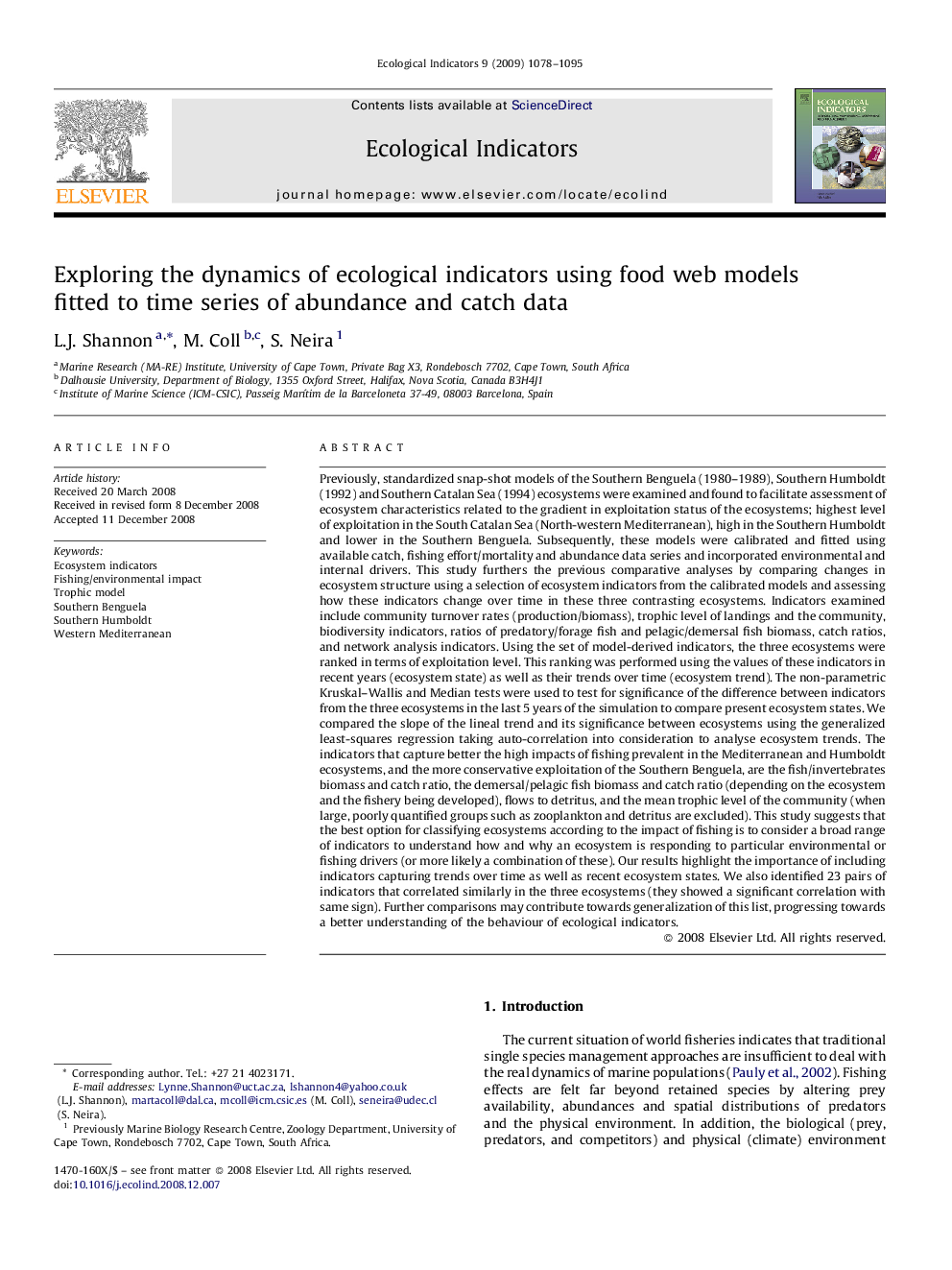| کد مقاله | کد نشریه | سال انتشار | مقاله انگلیسی | نسخه تمام متن |
|---|---|---|---|---|
| 4374336 | 1303170 | 2009 | 18 صفحه PDF | دانلود رایگان |
عنوان انگلیسی مقاله ISI
Exploring the dynamics of ecological indicators using food web models fitted to time series of abundance and catch data
دانلود مقاله + سفارش ترجمه
دانلود مقاله ISI انگلیسی
رایگان برای ایرانیان
کلمات کلیدی
موضوعات مرتبط
علوم زیستی و بیوفناوری
علوم کشاورزی و بیولوژیک
بوم شناسی، تکامل، رفتار و سامانه شناسی
پیش نمایش صفحه اول مقاله

چکیده انگلیسی
Previously, standardized snap-shot models of the Southern Benguela (1980-1989), Southern Humboldt (1992) and Southern Catalan Sea (1994) ecosystems were examined and found to facilitate assessment of ecosystem characteristics related to the gradient in exploitation status of the ecosystems; highest level of exploitation in the South Catalan Sea (North-western Mediterranean), high in the Southern Humboldt and lower in the Southern Benguela. Subsequently, these models were calibrated and fitted using available catch, fishing effort/mortality and abundance data series and incorporated environmental and internal drivers. This study furthers the previous comparative analyses by comparing changes in ecosystem structure using a selection of ecosystem indicators from the calibrated models and assessing how these indicators change over time in these three contrasting ecosystems. Indicators examined include community turnover rates (production/biomass), trophic level of landings and the community, biodiversity indicators, ratios of predatory/forage fish and pelagic/demersal fish biomass, catch ratios, and network analysis indicators. Using the set of model-derived indicators, the three ecosystems were ranked in terms of exploitation level. This ranking was performed using the values of these indicators in recent years (ecosystem state) as well as their trends over time (ecosystem trend). The non-parametric Kruskal-Wallis and Median tests were used to test for significance of the difference between indicators from the three ecosystems in the last 5 years of the simulation to compare present ecosystem states. We compared the slope of the lineal trend and its significance between ecosystems using the generalized least-squares regression taking auto-correlation into consideration to analyse ecosystem trends. The indicators that capture better the high impacts of fishing prevalent in the Mediterranean and Humboldt ecosystems, and the more conservative exploitation of the Southern Benguela, are the fish/invertebrates biomass and catch ratio, the demersal/pelagic fish biomass and catch ratio (depending on the ecosystem and the fishery being developed), flows to detritus, and the mean trophic level of the community (when large, poorly quantified groups such as zooplankton and detritus are excluded). This study suggests that the best option for classifying ecosystems according to the impact of fishing is to consider a broad range of indicators to understand how and why an ecosystem is responding to particular environmental or fishing drivers (or more likely a combination of these). Our results highlight the importance of including indicators capturing trends over time as well as recent ecosystem states. We also identified 23 pairs of indicators that correlated similarly in the three ecosystems (they showed a significant correlation with same sign). Further comparisons may contribute towards generalization of this list, progressing towards a better understanding of the behaviour of ecological indicators.
ناشر
Database: Elsevier - ScienceDirect (ساینس دایرکت)
Journal: Ecological Indicators - Volume 9, Issue 6, November 2009, Pages 1078-1095
Journal: Ecological Indicators - Volume 9, Issue 6, November 2009, Pages 1078-1095
نویسندگان
L.J. Shannon, M. Coll, S. Neira,